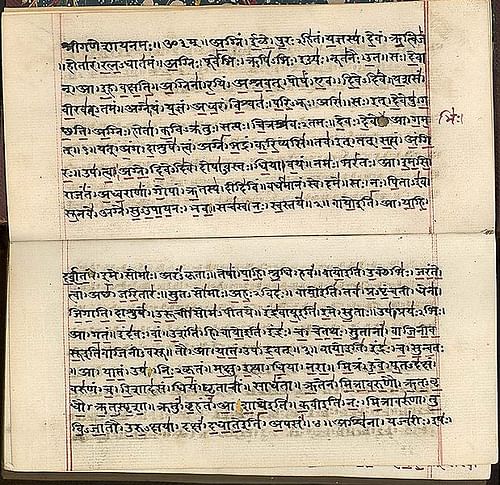Sutra
Sutra (Sanskrit: सुत्र, romanized: sūtra, lit. ’string, thread’) in Indian literary traditions refers to an aphorism or collection of aphorisms in the form of a manual or, more broadly, a condensed manual or text. Sutras are a genre of ancient and medieval Indian texts found in Hinduism, Buddhism, and Jainism.
In Hinduism, sutras are a distinct type of literary composition, a compilation of short aphoristic statements. Each sutra is any short rule, like a theorem distilled into a few words or syllables, around which the teachings of ritual, philosophy, grammar, or any field of knowledge can be woven. The oldest sutras of Hinduism are found in the Brahmana and Aranyaka layers of the Vedas. Each school of Hindu philosophy, Vedic guides to rituals, various fields of art, law, and social ethics have developed respective sutras to help teach and transmit ideas from one generation to the next.
In Buddhism, the sutras, also known as suttas, are canonical writings, many of which are believed to be records of the oral teachings of Gautama Buddha. They are not aphoristic, but rather detailed, sometimes with repetition. This may reflect the philological root of the sukta, rather than the sutras.
In Jainism, the sutras, also known as suyas, are the canonical teachings of Mahavira contained in the Jain Agamas as well as some later normative texts.
The Sanskrit word Sūtra means “string, thread”. The root of the word is siv, “that which sews and holds things together”. The word is related to sūci meaning “needle, list” and sūnā meaning “woven”.
In the context of literature, sūtra means a distilled collection of syllables and words, any form or handbook of “aphorism, rule, direction” hanging together like threads with which the teachings of ritual, philosophy, grammar, or any field of knowledge can be linked. woven.
A sūtra is any short rule, says Moriz Winternitz, in Indian literature; it is “a theorem condensed into a few words”. A collection of sutras becomes a text and is also called a sutra (often capitalized in Western literature).
A sūtra is distinct from other components such as Shlokas, Anuvyakhayas and Vyakhyas found in ancient Indian literature. A Sūtra is a condensed rule that conveys a message succinctly, while a Shloka is a verse that conveys a complete message and is structured according to certain rules of musical meter, Anuvyakhaya is an explanation of a reviewed text, while Vyakhya is an author’s commentary. reviewer.
The Sutras first appear in the Brahmana and Aranyaka strata of Vedic literature. They grow in number in the Vedangas such as the Srauta Sutras and the Kalpa Sutras. These were designed to be easily communicated from teacher to student, memorized by the recipient for discussion, self-study or as a reference.
The sutra itself is a condensed shorthand, and the threads of the syllable are difficult to decipher or understand without an associated scholarly Bhasya or deciphering commentary that fills out the “weaving”.
The earliest manuscripts to survive into the modern era that contain extensive sutras are parts of the Vedas, dating from the late 2nd millennium BCE to the mid-1st millennium BCE The Aitareya Aranyaka, for example, Winternitz states, is primarily a collection of sutras. Their use and ancient roots are attested by the sutras that are mentioned in the larger genre of ancient non-Vedic Hindu literature called Gatha, Narashansi, Itihasa and Akhyana (songs, legends, epics and stories).
In the history of Indian literature, large compilations of sutras in various fields of knowledge have been traced to the period from 600 BCE to 200 BCE (mostly after the Buddha and Mahavira), and this has been called the “Sutra Period”. This period followed the ancient Chhandas period, the Mantra period and the Brahmana period.
The (ancient) Indian student learned these sutras of grammar, philosophy, or theology by the same mechanical method that fixes the alphabet and the multiplication table in our (modern era) minds.
Classification






